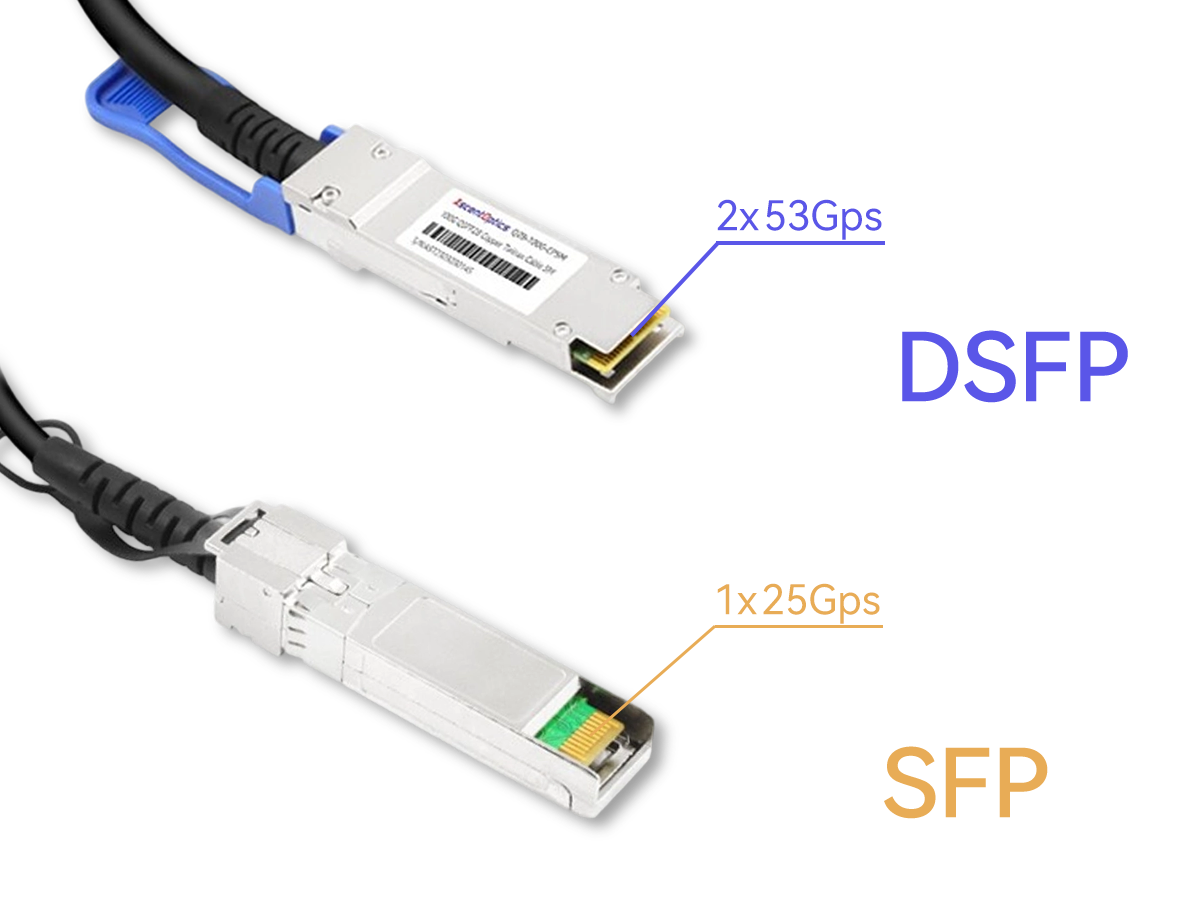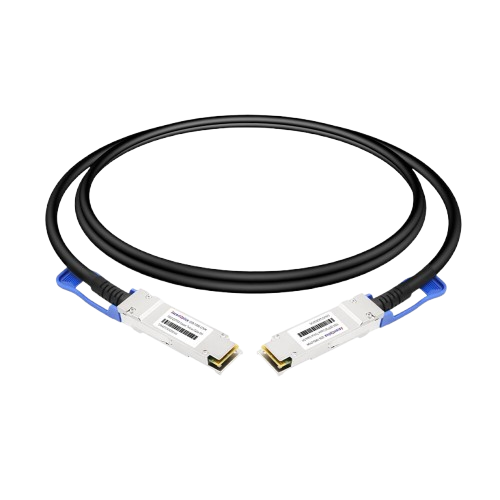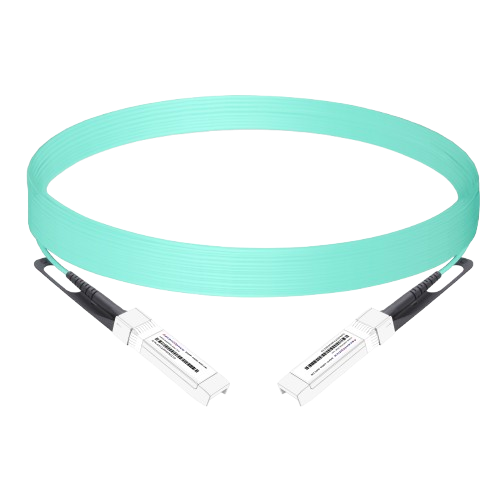As bandwidth and efficiency demands surge in data centers, 5G, and enterprise networks, traditional SFP interfaces can no longer meet the need for higher transmission rates. Meanwhile, larger packages such as QSFP face challenges in compact, high-density environments. To achieve higher bandwidth density in limited space, DSFP (Dual Small Form-factor Pluggable) has emerged as an ideal solution.
With its higher density, lower power consumption, and excellent cost-effectiveness, DSFP packaging becomes the ideal choice. Additionally, DSFP offers good backward compatibility, allowing users to smoothly upgrade network bandwidth based on existing SFP infrastructure, thereby reducing deployment costs. DSFP provides a compact and efficient solution for next-generation medium-speed optical interconnections.
DSFP (Dual Small Form-factor Pluggable) is a high-density optical transceiver form factor designed for data centers, high-performance computing (HPC), and telecom networks. As a next-generation dual-channel compact interface, DSFP delivers higher transmission rates and port density while maintaining the compact footprint of traditional SFP modules.
Physically identical to standard SFPs, DSFP introduces a dual-channel architecture that effectively doubles the bandwidth within the same interface. For example, a single DSFP port supports 2×25G, achieving a total data rate of 50G—significantly increasing bandwidth efficiency and port density without expanding panel space.
With continuous advancements in low-power SerDes technology, high-speed signal processing, and thermal management, DSFP enables stable high-speed data transmission within a small form factor. Its core goal is to double the module density of SFPs while maintaining full interoperability with existing SFP modules and cables, enabling seamless network upgrades with improved energy efficiency.

Dual-Channel Design: Achieves double the bandwidth in an SFP-sized interface.
High Density: Enables a higher number of ports in the same panel space.
Energy-Efficient: Power consumption per Gbps is lower than traditional SFP or SFP28.
Cost-Effective: Compared to high-end interfaces like QSFP, DSFP offers advantages in cost and power consumption.
Smooth Upgrade: Supports upgrades from 25G to 50G/100G application scenarios.
To address short- and medium-distance 100G interconnect needs, AscentOptics has launched 100G DSFP DAC (Direct Attach Copper) and 100G DSFP AOC (Active Optical Cable) solutions. Combining high performance, low power, and high density, they are ideal for next-generation data centers, AI clusters, and 5G transport networks.

DAC emphasizes low cost, low power consumption, and low latency, with maximum distances typically limited to 0.5-3m, suitable for environments with minimal EMI interference and short-distance high-density connections. Main scenarios include:
1.Intra-rack interconnections in data centers
Direct connections from servers and storage devices to TOR (Top of Rack) switches, supporting high-density port deployments, such as achieving more 100G ports in 1RU devices.
2. High-Performance Computing (HPC) clusters
Short-distance interconnections between GPUs or CPUs, used for computation-intensive tasks like scientific simulations and weather forecasting.
3. Cloud infrastructure
Short links inside virtualized servers, suitable for cost-sensitive cloud service providers.
4. Enterprise network equipment testing
In laboratories or small data centers, for rapid prototype validation and short-distance debugging.
5. 5G fronthaul networks
Short-distance connections inside base stations, supporting the high-density requirements of emerging 5G deployments.

AOC provides better signal integrity, EMI resistance, and longer distances (1-100m), with slightly higher power consumption but strong flexibility, suitable for inter-rack or EMI environments. Main scenarios include:
1. Inter-rack interconnections in data centers:
In Leaf-Spine architectures, connections from TOR switches to EoR (End of Row) switches or cross-rack links, supporting large-scale data transmission.
2. AI and machine learning clusters:
Interconnections between GPU clusters, used for AI training and inference tasks, ensuring low latency and high bandwidth.
3. Storage networks (SAN/NAS):
Medium-distance links in distributed storage systems, enhancing I/O performance, such as in database clusters.
4.Telecommunications and 5G midhaul/backhaul:
Interconnections from base stations to the core network, supporting 5G high-density deployments and edge computing.
5. Enterprise data center expansions:
Medium-distance internal links, such as in multi-story buildings or expanded data halls, providing lightweight cabling.
In actual deployments, DAC is suitable for budget-limited short-distance scenarios, but if failure rates are high (such as copper cable aging), consider switching to AOC to improve reliability. Overall, DSFP is applicable to environments pursuing port density and future upgrades (such as to 200G).
After understanding the differences between DAC and AOC applications, we can further compare DSFP with the mainstream QSFP28 solutions to help make better deployment decisions.
In 100G networks, DSFP and QSFP28 are two common interface solutions. DSFP offers a smaller form factor, making it ideal for high-density deployments, while QSFP28 features a more mature ecosystem and broader compatibility. The choice depends on factors such as port compatibility, transmission distance, density requirements, cost, and power consumption. The following section provides a detailed comparison and deployment recommendations.
| Parameter | 100G DSFP DAC | 100G DSFP AOC | 100G QSFP28 DAC | 100G QSFP28 AOC |
|---|---|---|---|---|
| Form Factor | DSFP (Compact, Dual Channel) | DSFP (Compact, Dual Channel) | QSFP28 (Quad Channel) | QSFP28 (Quad Channel) |
| Channel Configuration | 2×50G PAM4 | 2×50G PAM4 | 4×25G NRZ | 4×25G NRZ |
| Maximum Distance | 0.5–3m | 1–100m | 0.5–5m | 1–100m |
| Power Consumption | <0.5W (Passive) | 1–3W (Active) | <0.5W (Passive) | 2–3.5W (Active) |
| Cost | Lowest | Medium | Low | Medium to High |
| Port Density | High (Double SFP Density) | High (Double SFP Density) | Medium | Medium |
| Weight / Flexibility | Heavier, More Rigid | Light, Flexible | Heavier, More Rigid | Light, Flexible |
| EMI Resistance | Medium | High | Medium | High |
| Latency | Lowest | Low | Lowest | Low |
| Typical Application | Short-range, high-density in-rack connections | Medium-range, high-density inter-rack connections | Short-range, standard in-rack connections | Medium-range, standard inter-rack connections |
| Compatibility | New devices, limited support | New devices, limited support | Wide (Cisco, Arista, etc.) | Wide (Cisco, Arista, etc.) |
1.Transmission Distance: If distance <5m, choose DAC to save costs and reduce power consumption; >5m or in EMI environments, choose AOC to ensure signal quality.
2. Density and Scalability: When needing to maximize port count (such as more 100G ports in 1RU), prioritize DSFP. It is small in size, provides higher density, and is easy to upgrade to 200G. QSFP28 is suitable for existing infrastructure.
3. Cost and Power Consumption: When budget is limited and distance is short, select DAC (DSFP or QSFP28). AOC is more expensive, but reliable in the long term, especially during data center expansions.
In conclusion, the 100G DSFP DAC and AOC series from AscentOptics deliver compact, high-density, and energy-efficient interconnect solutions for modern data centers. Their scalability and flexibility make them ideal for future upgrades toward 200G and beyond.